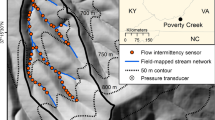Abstract
Longitudinal profiles of water quality along a well-mixed tidal river are, ideally, based on simultaneous measurements at fixed stations distributed along the river. The resolution of the profiles is limited by the density of the stations. However, for a given number of stations the resolution is greatly increased if water quality date can be extrapolated upstream and downstream of the stations, making use of velocity data; the resolution is then determined by the density of the extrapolated data points, which may be an order of magnitude higher than the density of the stations.
A 15-km length of river was investigated using 5 current meters equipped to measure depth, temperature, conductivity and dissolved oxygen. Data were recorded simultaneously every 10 minutes. When the average cross-sectional speed was 0.25 ms−1 (typical of tidal conditions), the extrapolated data points were 150 m apart, so the resolution of the resulting profiles (7 per kilometre) was much higher than that of the stations alone (0.3 per kilometre).
The extrapolation process required a means of deducing the average cross-sectional speed from the speed measured at a given station. The key to this was provided by temperature data recorded during the onset of a spate, when tidal flow was suspended and the average cross-sectional speed was uniformly about 0.75 ms −1 at four of the stations.
Profiles of temperature and dissolved oxygen were generated by this method; the resolution was about 2 data points km−1 during the onset of the spate, and 6 points km−1 during tidal flow.
Similar content being viewed by others
References
Alabaster, J. S., 1972. Oxygen in estuaries: requirements for fisheries. In A. L. H. Gameson (ed.), Mathematical and hydraulic modelling of estuarine pollution. Her Majesty's Stationery Office, London: 16–23.
Ozturk, Y. F., 1979. Mathematical modelling of dissolved oxygen in mixed estuaries. J. Envir. Eng. Div., Proc. Am. Soc. Civil Eng., 105: 883–904.
Ozturk, Y. F., 1981. Mathematical modelling of dispersion in mixed estuaries. J. Envir. Eng. Div., Proc. Am. Soc. Civil Eng., 107: 211–228.
Pennington, R. H., 1965. Introductory computer methods and numerical analysis. Macmillan, New York, pp. 452.
Rankin, R. O. & S. N. Milford, 1979a. Computer simulation of Brisbane River — Part 1 Salinity. J. Aust. Water Wastewater Ass., 6(1):9–16.
Rankin, R. O. & S. N. Milford, 1979b. Computer simulation of Brisbane River — Part 2 Dissolved Oxygen. J. Aust. Water Wastewater Ass., 6(2): 14–16.
Rankin, R. O. & S. N. Milford, 1980. Investigation of estuarine salinity and dissolved oxygen in the Brisbane River. J. Aust. Water Wastewater Ass., 7, (1) 12–13.
Steele, J. G., 1976. The Brisbane River. Rigby, Adelaide, 63 pp.
Uncles, R. J., 1979. A comparison of the axial distributions of salt and 137Cs in the Severn Estuary during August 1974. Estuarine and Coastal Marine Science, 9, 585–594.
Author information
Authors and Affiliations
Rights and permissions
About this article
Cite this article
Steele, J.G. High-resolution profiles of temperature and dissolved oxygen in a river. Hydrobiologia 179, 17–24 (1989). https://doi.org/10.1007/BF00011926
Received:
Revised:
Accepted:
Issue Date:
DOI: https://doi.org/10.1007/BF00011926




